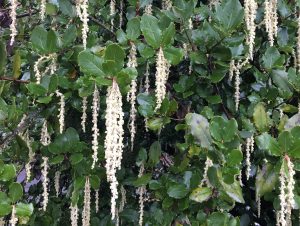I spend a lot of time at Hoyt Arboretum regardless of the season. In non-pandemic times, I volunteer as a naturalist, taking elementary school students on hikes to teach them about the Arboretum and the cool trees and plants found here.
Outside of the school season, I hike and jog on the trails. I’m not a fast jogger, just an impatient hiker really, but running allows me to cover more territory when I’m outside and the real pleasure of Hoyt Arboretum is that every season offers something. Every day that I get out on Hoyt Arboretum’s trails, I discover new plants or new ways of thinking.
This week, in the depths of winter, as I was jogging the Marquam Trail, I noticed an interesting evergreen shrub with long unusual gray-green appendages hanging down from the tips of branches. I was thrilled to recognize the distinctive foliage and catkins of Garrya elliptica, the Coast silk-tassel shrub. I hadn’t seen the silk-tassels shrubs before, but there are so many fun secret plants in Hoyt Arboretum, I wasn’t surprised.
The Coast, or wavey-leaf, silk-tassel bush is native to the southern Oregon-mid-California Coastal mountains. The silk-tassel prefers the cooler end of the Mediterranean climate spectrum, which is why it’s on the coast and is found on north-facing slopes inland to central California. The shrub was documented by David Douglas on one of his plant hunting expeditions to the Pacific Northwest in the 1830s, and is named after Nicholas Garry, one of Douglas’s assistants. The plant is dioecious, which means that there are separate male and female plants. Male plants have their flowers in elongated dangling clusters called catkins, which are highly visible at this time of year. Female plants have smaller clusters of inconspicuous flowers. It’s a wonderful west coast native evergreen landscape shrub, not fussy about soil, but does prefer lots of sun and some summer water, if possible, in our area. It grows to about 12 feet tall and makes a great casual hedge in a larger yard. Look for it as you walk on the Marquam Trail behind the World Forestry Center.
There is also a really nice large shrub of Garrya elliptica ‘James Roof’ located in the Visitor Center parking lot. This cultivar is a male selection that has extremely long catkins of male flowers and is particularly showy at this time of the year.
The Garrya elliptica was my surprise of the week; I look forward to spotting other surprises on future hikes at Hoyt Arboretum as winter progresses towards spring.
About the Author



